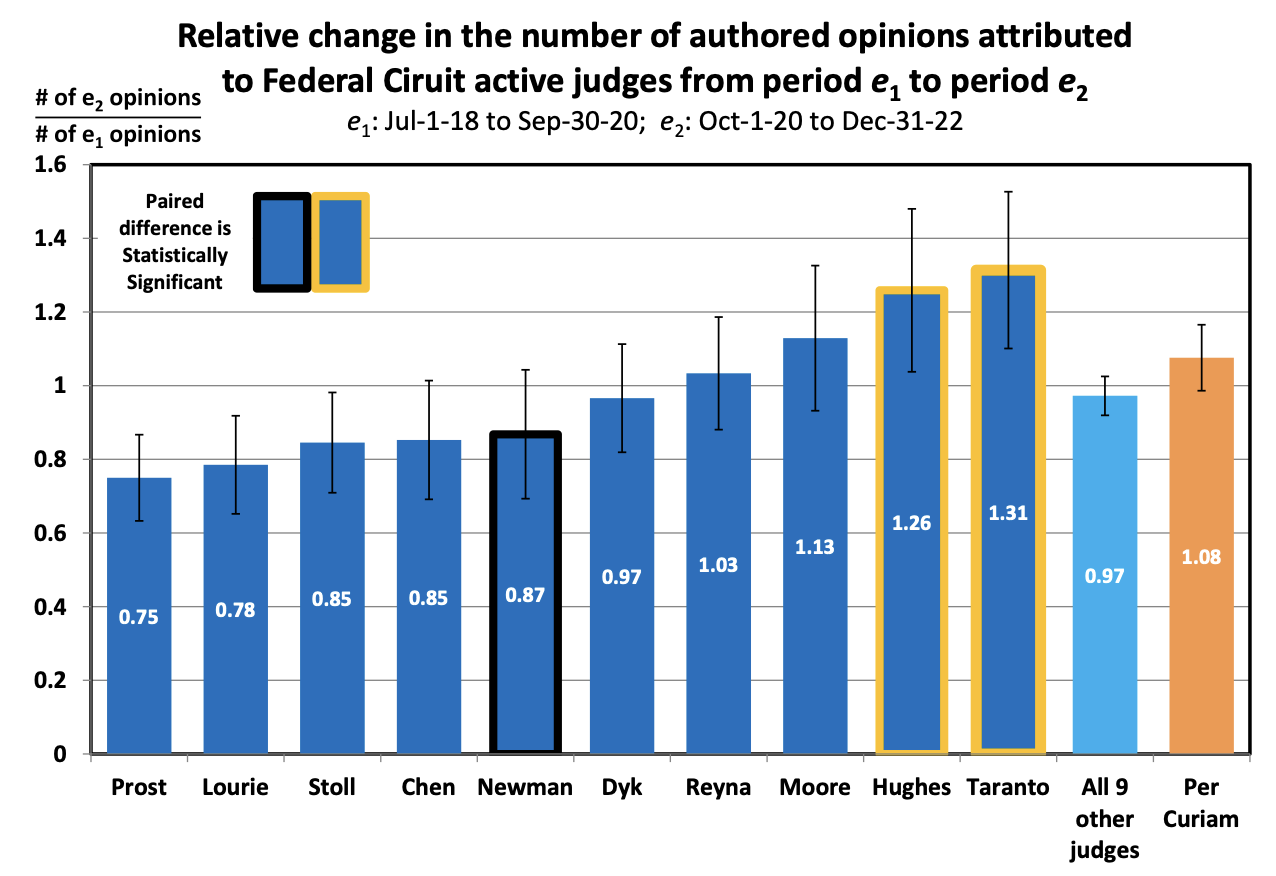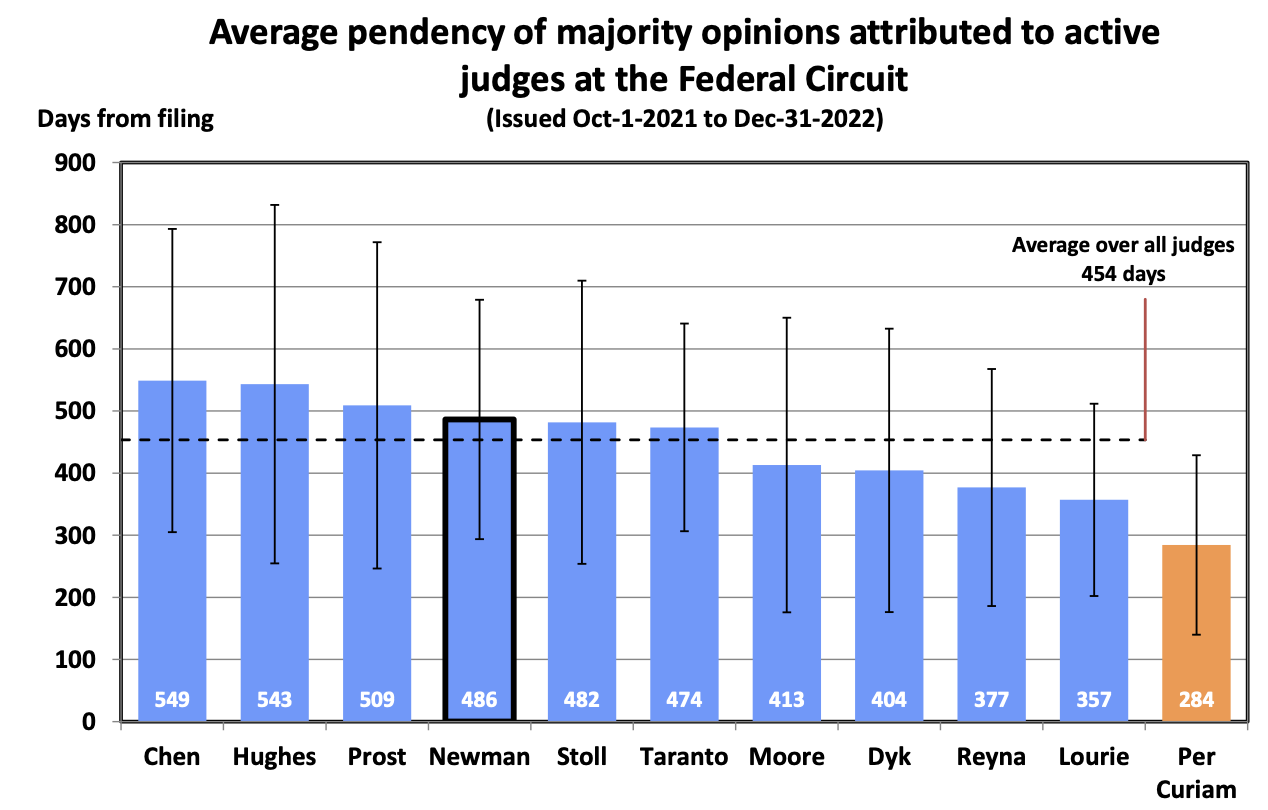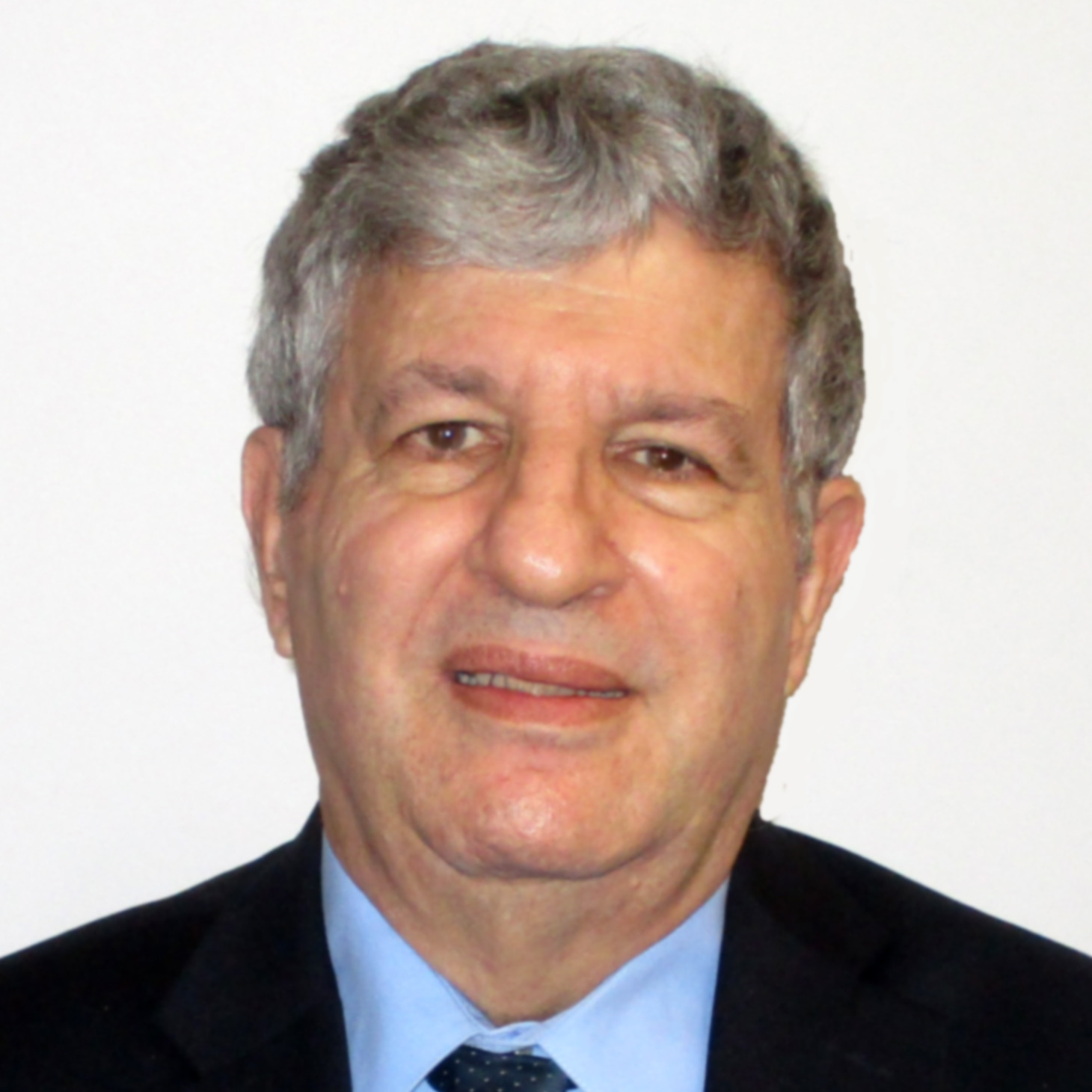“[T]he available evidence does not support the Complaint’s contention that Judge Newman’s performance has adversely changed in any statistically-significant way compared to that of her colleagues on the court.”
 As the readers of this blog know, the Special Committee of the Judicial Council of the Federal Circuit is investigating a complaint identified against Federal Circuit Judge Pauline Newman. The Complaint alleges that Judge Newman “is unable to discharge all the duties of office by reason of mental or physical disability.” As a result, the Complaint essentially alleges, Judge Newman has authored too few majority (including unanimous per curiam) opinions compared to her colleagues, ignoring altogether the disproportionately larger number of her authored dissenting opinions.
As the readers of this blog know, the Special Committee of the Judicial Council of the Federal Circuit is investigating a complaint identified against Federal Circuit Judge Pauline Newman. The Complaint alleges that Judge Newman “is unable to discharge all the duties of office by reason of mental or physical disability.” As a result, the Complaint essentially alleges, Judge Newman has authored too few majority (including unanimous per curiam) opinions compared to her colleagues, ignoring altogether the disproportionately larger number of her authored dissenting opinions.
In the latest update to the investigation, Judge Newman yesterday filed a Memorandum of Law in Support of Plaintiff’s Motion for a Preliminary Injunction asking the U.S. District Court for the District of Columbia to enjoin the Special Committee from continuing the suspension of Newman’s judicial functions. Newman argues in part that her medical records do not corroborate the Complaint’s accusations that she suffered a heart attack and has a coronary artery disease and that a recent examination by “a qualified neurologist…revealed no significant cognitive deficits and led that expert to conclude that Judge Newman’s ‘cognitive function is sufficient to continue her participation in her court’s proceedings.’”
Prejudicial Productivity Standard
In a breathtaking admission, the Judicial Council of the Federal Circuit, comprised of all active Federal Circuit judges, complained in its Order of June 5 that Judge Newman’s conduct necessitated “several interventions over the previous 18 months in which cases had been reassigned from her to another judge following … the circulation of draft opinions that no other member of the panels would join.” Normally, these draft opinions would be called “dissents.”
This one-sided majoritarian focus discards the utility of dissenting opinions and prejudices their authors. Whether intended or not, the unavoidable inference from the Complaint’s prejudicial productivity standard is that Judge Newman’s alleged “disability” impedes her ability to author sufficient number of majority and unanimous opinions that “other member of the panels would join.”
When authorship of only majority or unanimous opinions becomes the standard of productivity to which a judge is held by her Chief Judge, there is great cause for concern that dissents on the court are discouraged, if not silenced. This is particularly so when that standard is used to reassign cases for which the judge drafts dissenting “opinions that no other member of the panels would join,” and to justify removal of the judge from a Presidentially-appointed, Senate-confirmed office.
Nevertheless, if true, the allegations of Judge Newman’s productivity loss and “habitual delays” are serious enough to warrant further study of the evidence. To this end, my recent article provides an analysis of the facts as independently obtained from a comprehensive Federal Circuit decision dataset. The analysis reveals that Judge Newman was by no means an under-performer among her colleagues on the court.
Statistical Analysis of Federal Circuit Decisions
I conducted a temporal trend analysis comparing the number of authored panel opinions over two consecutive periods, the latter being the period during which Judge Newman allegedly suffered a “disability.” One such analysis shows that the relative change in the number of authored opinions attributed to Judge Newman between those two consecutive periods was statistically indistinguishable from the corresponding relative change in the number of authored opinions attributed to all other active judges over these consecutive periods (see figure below). The inference is that any change in authored opinion productivity attributed to Judge Newman during the period of her alleged “disability” essentially tracked similar changes in the productivity attributed to her colleagues and must therefore be presumed unrelated to, or not caused by, specific attributes unique to Judge Newman’s performance.
 My study also shows that authored opinions attributed to Judge Newman were predominantly dissents—the type of opinions that my study shows to have taken substantially more time to issue than majority or unanimous opinions. Despite this extended workload per opinion that disproportionately affected Judge Newman, in the most recent period of FY 2022 and the first quarter of FY 2023, another active judge on the court was attributed with authoring fewer total opinions. In addition, because the Complaint focused on majority opinions, alleging Judge Newman’s “habitual delays” compared to her colleagues, I found that in that period, the average pendency of authored majority opinions attributed to each of three other active judges on the court was longer than those attributed to Judge Newman in the same period. See the average pendency figure below.
My study also shows that authored opinions attributed to Judge Newman were predominantly dissents—the type of opinions that my study shows to have taken substantially more time to issue than majority or unanimous opinions. Despite this extended workload per opinion that disproportionately affected Judge Newman, in the most recent period of FY 2022 and the first quarter of FY 2023, another active judge on the court was attributed with authoring fewer total opinions. In addition, because the Complaint focused on majority opinions, alleging Judge Newman’s “habitual delays” compared to her colleagues, I found that in that period, the average pendency of authored majority opinions attributed to each of three other active judges on the court was longer than those attributed to Judge Newman in the same period. See the average pendency figure below.
 Note also that the average pendency of per curiam opinions (publically unknown panel member author) is 170 days less than the attributed pendencies averaged over all active judges. This indicates that such essentially unanimous opinions require reduced workload compared to authored majority opinions to which judges receive authorship attribution by name.
Note also that the average pendency of per curiam opinions (publically unknown panel member author) is 170 days less than the attributed pendencies averaged over all active judges. This indicates that such essentially unanimous opinions require reduced workload compared to authored majority opinions to which judges receive authorship attribution by name.
The Special Committee Order of May 16 argues that unlike the Court’s internal data, “public data reflecting the time between an appeal being docketed and terminated does not indicate the time between when a judge is assigned an opinion and when the opinion issues,” and that the “Court’s internal data also accounts for delays in authorship attributed to stays or reassignments.” It is true that the average pendencies shown in the figure above are based on the appeal filing date, pendencies that also include all preprocessing, briefing, screening, assignment, internal circulation for review, and docketing delays. However, for Judge Newman to appear an outlier with longer net authorship time consistent with this figure, the total pre-assignment delays for cases later assigned to her should have been disproportionately and materially shorter than those for her colleagues. There is no evidence that the procedures of the Federal Circuit could have resulted in specifically expediting the authorship assignment only to Judge Newman. Full disclosure of the Federal Circuit’s internal data on case assignment dates, and more importantly, the extent to which the inclusion of per curiam opinion pendencies selectively biased the results downwards for judges other than Newman would be necessary for drawing any further conclusions.
My article reports on more statistical tests regarding service on panels and concludes that the available evidence does not support the Complaint’s contention that Judge Newman’s performance has adversely changed in any statistically-significant way compared to that of her colleagues on the court. My analysis reveals a much more nuanced account of the factors that affect the number of authored opinions by any given judge. These factors in any given case are much less subject to the judge’s control than the Complaint implies. For example, the panel’s dynamics and propensity to adopt per curiam, or Rule 36 decisions impose a disproportionate systemic constraint on a dissenting judge’s opportunity to author opinions, which has little to do with productivity.
Potential Conflict of Interests
A dissenting judge necessarily creates additional workload for her colleagues. The additional workload for colleagues is palpable: not only is the dissenting judge taken out of the contributing pool of majority opinion authors for those cases, but her colleagues are assigned the additional majority opinion authorship jobs. Furthermore, those majority opinions that her colleagues must author in the face of her dissents take substantially more work, as they are lengthier and must not only address the merits of the case but also the specific grounds and precedents raised by the dissent. My analysis shows that assuming a 12-active-judge court, replacing Judge Newman (who dissents 53% of the time) with a new Circuit Judge, having a 5% dissent rate (the average for all other active judges in this study), would result in substantial authorship workload reduction by an average of about 5% for each of her colleagues. Her colleagues who would derive personal benefit from that workload reduction are members of the Special Committee investigating Judge Newman’s alleged productivity loss, and more broadly, all other members of the Judicial Council of the Federal Circuit, the body currently adjudicating the Complaint that seeks to remove Judge Newman from active office. This is a structural bias.
The appearance of a conflict of interests raises substantial questions as to the structural bias, including in the setting of the prejudicial standards and collecting evidence for evaluating Judge Newman’s productivity in comparison to her colleagues on the court. It raises serious questions as to the refusal of her colleagues to transfer the matter to an independent Judicial Council for investigation and adjudication. Ultimately, there is a question whether the Complaint seeks to remove Judge Newman from office to silence dissent at the Federal Circuit.
This question deserves heightened scrutiny in the case of the Federal Circuit—the sole appellate tribunal nationwide for appeals under the patent law since 1982. Decisions under other laws from multiple circuit courts of appeal provide a safety net through the national diversity of circuit holdings on a given subject. In contrast, suppressing dissent at the Federal Circuit is far more dangerous as it removes the safety net by putting a nationwide stranglehold on any opposing view and creating a singular decision on a subject, which the Supreme Court is less likely to review.
Download my full article at SSRN https://ssrn.com/abstract=4489143.

![[IPWatchdog Logo]](https://ipwatchdog.com/wp-content/themes/IPWatchdog%20-%202023/assets/images/temp/logo-small@2x.png)

![[Advertisement]](https://ipwatchdog.com/wp-content/uploads/2024/04/UnitedLex-May-2-2024-sidebar-700x500-1.jpg)
![[Advertisement]](https://ipwatchdog.com/wp-content/uploads/2024/04/Artificial-Intelligence-2024-REPLAY-sidebar-700x500-corrected.jpg)
![[Advertisement]](https://ipwatchdog.com/wp-content/uploads/2024/04/Patent-Litigation-Masters-2024-sidebar-700x500-1.jpg)

![[Advertisement]](https://ipwatchdog.com/wp-content/uploads/2021/12/WEBINAR-336-x-280-px.png)
![[Advertisement]](https://ipwatchdog.com/wp-content/uploads/2021/12/2021-Patent-Practice-on-Demand-recorded-Feb-2021-336-x-280.jpg)
![[Advertisement]](https://ipwatchdog.com/wp-content/uploads/2021/12/Ad-4-The-Invent-Patent-System™.png)






Join the Discussion
12 comments so far.
ghostndragon
July 17, 2023 09:46 am“Ultimately, there is a question whether the Complaint seeks to remove Judge Newman from office to silence dissent at the Federal Circuit.”
This. This is the issue. Not only does Newman (rightfully) disagree with many of the majority opinions, she does so openly, clearly, and with legal and scientific support. Judge Newman’s dissents PUBLICLY tether each case to an anchor supported by law, which makes it clear how far away the majority opinions have drifted from this anchor.
David Hong
June 30, 2023 12:55 pmIn the next to last paragraph of Dr. K’s fantastic article: “In contrast, suppressing dissent at the Federal Circuit is far more dangerous as it removes the safety net by putting a nationwide stranglehold on any opposing view and creating a singular decision on a subject, which the Supreme Court is less likely to review.”
This is the Rub!
I doubt if anyone outside the Patent Bar is watching this curious fight, but it is an assault on freedom.
Judge Newman has to prevail.
Anon
June 29, 2023 06:17 pmTo Ron’s last comment, I am curious as to what exactly does Josh feel is “dangerous.”
The danger that is see is not in Ron’s factual dissertation, nor in anything attributable to Judge Newman.
But that is the danger that I see.
What is the danger that Josh sees?
Ron Katznelson
June 29, 2023 02:49 pmJosh,
Like you, I am perplexed – – what changed? What changed to cause Judge Newman’s colleagues to allege that her productivity after October 2020 was unacceptable (compared to her colleagues) to such a degree as to be “prejudicial to the efficient administration of justice”? What really changed when the evidence shown in Table 2 of my article and depicted in my first figure above contradicts this allegation? Instead, the evidence shows that the relative decline in the number of authored opinions attributed to Judge Newman during October 1, 2020, through December 31, 2022 (2 ¼ years) over the previous 2 ¼ years starting in July 1, 2018, was statistically indistinguishable from the corresponding relative decline observed in the total number of authored opinions attributed to all 9 other judges. Moreover, no one suggested that the steeper relative decline of productivity attributed to four (4) other judges on the court compared to that of Judge Newman is “prejudicial to the efficient administration of justice.”
Perhaps, Josh, you may be able to divine what really changed at the Federal Circuit? Or identify what in my statistical analysis is “ridiculous” according to you?
Nick Landau
June 29, 2023 01:46 pmWhat is Federal Circuit Clerical Procedures #3, ¶ 15, and is Judge Newman actually in violation of it?
B
June 29, 2023 09:09 am@ Josh “So I’m to believe that several judges are out to get Newman because suddenly her 40 years of dissents and pro-patent views are too much.”
Did you read the Yu v. Samsung opinion? How about CLS v. Alice Corp en banc?
I’d say Judge Newman has a history of embarrassing her collogues, but the truth is said collogues embarrass themselves with Newman being the foil.
B
June 29, 2023 08:42 amGREAT ARTICLE!
BTW, reading between the lines of the complaint I see how those reassigned cases were “resolved” so quickly. Throw an R-36 out so as to make it in time for dinner and drinks at Kellari’s (hey – only a pro se after all) . . . or have a clerk fabricate legal research to justify a pre-ordained decision.
BTW, Judges Stoll, Hughes, Prost took over 150 days after oral argument in In re Villena to spew 500 words that ignored every argument before them. As to voting on other judge’s decisions, the CAFC is clearly delinquent considering the idiotic decisions of Taranto, Hughes, Reyna, Chen . . . who’ve produced some of the most bizarre garbage ever.
I’m less worried about delays “prejudicial to the efficient administration of justice” than I am actual injustice.
Josh
June 29, 2023 08:17 amSo I’m to believe that several judges are out to get Newman because suddenly her 40 years of dissents and pro-patent views are too much.
Knock it off. This is as dangerous as is it is ridiculous.
Erich Spangenberg
June 29, 2023 06:05 amRon — Great post. I just don’t get it. Judge Moore IMO has a wildly impressive educational and professional background and is a good judge (putting aside I do not agree with some of her rulings). Why this fight with Judge Newman? Judge Moore and her fellow judges pushing this curious effort must have known that someone like you was going to take a look at the data. We can argue about the data, but the burden is on Judge Moore and you have shown she can’t carry it (at best, inconclusive; probably, just wrong). I get it — dissents are annoying. So what. Judge Moore is tarnishing her and the court’s image–why? What is it that Judge Moore wants to achieve that she is willing to do so much harm?
Anon
June 29, 2023 04:21 amI find it no coincidence that many who would rail against Ron K (in most any of his positions) are the same that cheer on the attacks of Judge Newman and blame her for “getting in the way and bringing shame to the CAFC.”
Yes, I am looking at a cadre of litigators and other patent blog pundits that I have consistently labeled as anti-patent.
Julie Burke
June 29, 2023 03:13 amAnd when our patent world once again careens into chaos & corruption, thank you, Dr. Katznelson for gathering necessary data and providing stellar, in depth analysis of the pertinent facts to shine a light of reason on the craziness. I hope rational thought prevails.
Pro Say
June 28, 2023 06:25 pmWhen the destination is known (here, the removal of Judge Newman), the illegal and unconstitutional paths are many.